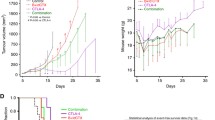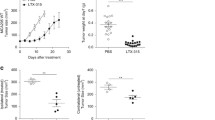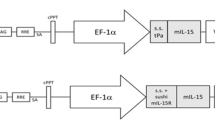Abstract
The therapeutic efficacies of two chemical agents—cyclophosphamide (CY) and compound CBM-11—were compared in a chemo-immunotherapy protocol combining a single injection of a cytotoxic agent with a series of weekly peritumoural (p.t.) administrations of nontumourigenic plasmocytoma cells engineered to produce interleukin-2 (IL-2). Compound CBM-11, an optically active S(−) isomeric form of a bromine-substituted analogue of ifosfamide, is currently used in Phase I clinical trials in Poland. The treatment was applied to mice bearing well-established subcutaneous (s.c.) MC-38 colon tumours. Single intraperitoneal injection of 200 mg/kg of CY or of an equitoxic dose of 140 mg/kg of CBM-11 alone resulted in a tumour growth delay (TGD) of 10–13 and 17–21 d, respectively. This effect was accompanied by an increase in life-span (ILS) of at most 42 and 62% over control. Complete responses (CR) were not observed. Combination of CY or CBM-11 with 6–7 p.t. injections of IL-2-secreting cells resulted in potentiation of the therapeutic effects: TGD and ILS values were considerably increased and long-lasting CRs were observed. The overall incidence of CR after combined treatment was ca 16% and 42% for CY and CBM-11, respectively (P=0.049). A specific anti-MC-38 immunity was induced by the treatment, as verified by rechallenge of cured mice with MC-38 tumour cells 3–4 months post therapy cessation. Our results indicate that tumour destruction by chemotherapy (even if not complete) and prolonged local delivery of IL-2 secreted by allogeneic cells of an easy to culture line are sufficient to secure long-lasting specific antitumour immunity in cured mice.
Similar content being viewed by others
References
Pardoll DM. Paracrine cytokine adjuvants in cancer immunotherapy.Annu Rev Immunol 1995;13: 399–415.
Janssen RAJ, Mulder NH, Hauw The T, de Leij L. The immunobiological effects of interleukin-2 in vivo.Cancer Immunol Immunother 1994;39: 207–216.
Sone S, Ogura T. Local interleukin-2 immunotherapy.Oncology 1993;51: 170–176.
Sencer SF, Rich ML, Katsanis E, Ochoa AC, Anderson PM. Antitumor vaccine adjuvant effects of IL-2 liposomes in mice immunized against MCA-102 sarcoma.Aur Cytokine Network 1993;2: 311–318.
Egilmez NKet al. Cytokine immunotherapy of cancer with controlled release biodegradable microspheres in a human tumor xenograft/SCID mouse model.Cancer Immunol Immunother 1998;46: 21–24.
Cordier Let al. Complete recovery of mice from a pre-established tumor by direct intratumoral delivery of an adenovirus vector harboring the murine IL-2 gene.Gene Ther 1995;2: 16–21.
Addison CLet al. Intratumoral injection of an adenovirus expressing interleukin 2 induces regression and immunity in a murine breast cancer model.Proc Natl cad Sci USA 1995;92: 8522–8526.
Lattime EC, Lee SS, Eisenlohr LC, Mastrangelo MJ. In situ cytokine gene transfection using vaccinia virus vectors.Semin Oncol 1996;23: 88–100.
Schmidt-Wolf GD, Schmidt-Wolf IGH. Cytokines and gene therapy.Immunol Today 1995;16: 173–175.
Jaffee EM, Pardoll DM. Considerations for the clinical development of cytokine gene-transduced tumor cell vaccines.Methods 1997;12: 143–153.
Parmiani G, Colombo MP, Melani C, Arienti F. Cytokine gene transduction in the immunotherapy of cancer.Adv Pharmacol 1997;40: 259–307.
Bannerji R, Arroyo CD, Cordon-Cardo C, Gilboa E. The role of IL-2 secreted from genetically modified tumor cells in the establishment of antitumor immunity.J Immunol 1994;152: 2324–2332.
Cavallo Fet al. Protective and curative potential of vaccination with interleukin-2 gene tranfected cells from a spontaneous mouse mammary adenocarcinoma.Cancer Res 1993;53: 5076–5080.
Chiang C-S, Dougherty GJ, Economou JS, McBride WH. Tumor-directed cytokine gene therapy. In: Hui KM (ed).Gene Therapy. From Laboratory to Clinic, World Scientific: Singapore 1994; pp 21–44.
Katsanis Eet al. Interleukin-2 gene transfer into murine neuroblastoma decreases tumorigenicity and enhances systemic immunity causing regression of pre-established retroperitoneal tumors.J Immunother 1994;15: 81–90.
Dong P, Brunn C, Ho RJY. Cytokines as vaccine adjuvants. Current status and potential application. In: Powell MF and Newman MJ (eds).Vaccine Design: The Subunit and Adjuvant Approach. Plenum Press: New York, 1995, pp 625–643.
Taylor CE. Cytokines as adjuvants for vaccines: antigen-specific responses differ from polyclonal responses.Infect Immun 1995;63: 3241–3244.
Knight BC, Souberbielle BE, Rizzardi GP, Ball SE, Dalgleish AG. Allogeneic murine melanoma cell vaccine: a model for the development of human allogeneic cancer vaccine.Melanoma Res 1997;6: 299–306.
Shawler DLet al. Comparison of gene therapy with interleukin-2 gene modified fibroblasts and tumor cells in the murine CT-26 model of colorectal carcinoma.J Immunother 1995;17: 201–208.
Mackensen Aet al. Induction of tumor-specific cytotoxic T lymphocytes by immunization with autologous tumor cells and interleukin-2 gene-transfected fibroblasts.J Mol Med 1997;75: 290–296.
Gilboa E, Nair SK, Lyerly HK. Immunotherapy of cancer with dendritic-cell-based vaccines.Cancer Immunol Immunother 1998;46: 82–87.
Armstrong TD, Pulaski BA, Ostrand-Rosenberg S. Tumor antigen presentation: changing the rules.Cancer Immunol Immunother 1998;46: 70–74.
Zatloukal Ket al. Elicitation of a systemic and protective anti-melanoma immune response by an IL-2-based vaccine.J Immunol 1995;154: 3406–3419.
Mitchell MS. Combining chemotherapy with biological response modifiers in treatment of cancer.J Natl Cancer Inst 1998;80: 1445–1450.
Pajtasz-Piasecka E, Kuśnierczyk H, Salwa J, Konarski L, Radzikowski C. Growth inhibition of transplantable tumors in mice by mIL-2 secreting murine plasmocytoma cells used alone or in combination with cytostatic agent.Arch Immunol Ther Exp 1995;42: 281–292.
Glazman-Kuśnierczyk H, Pajtasz-Piasecka E, Radzikowski C. Interleukin-2 therapy potentiates the antitumor effect of cytostatic agent in mice with advanced transplantable tumors.Biotechnologia. Polish-Japan Issue 1996;4: 68–79.
Glazman-Kuśnierczyk H, Matuszyk J, Radzikowski C. Antitumor activity evaluation of bromine-substituted analogues of ifosfamide. I. Stereodifferentiation of biological effects and selection of the most potent compounds.Immunopharmacol Immunotoxicol 1992;14: 883–911.
Apostolopoulos V, Popoviski V, McKenzie IFC. Cyclophosphamide enhances the CTL precursor frequency in mice immunized with MUC1-mannan fusion protein (MFP).J Immunother 1998;21: 109–113.
Mescher MF, Rogers JD. Immunotherapy of established murine tumors with large multivalent immunogen and cyclophosphamide.J Immunother 1996;19: 102–112.
Hosokawa Met al. Improved therapeutic effects of interleukin 2 after the accumulation of lymphokine-activated killer cells in tumor tissue of mice previously treated with cyclophosphamide.Cancer Immunol Immunother 1988;26: 250–256.
Kedar E, Ben-Aziz R, Epstein E, Leshem B. Chemo-immunotherapy of murine tumors using interleukin-2 (Il-2) and cyclophosphamide. IL-2 can facilitate or inhibit tumor growth depending on the sequence of treatment and the tumor type.Cancer Immunol Immunother 1989;29: 74–78.
Papa MZet al. Combined effects of chemotherapy and interleukin 2 in the therapy of mice with advanced pulmonary tumors.Cancer Res 1988;48: 122–129.
Corbett TH, Griswold DP Jr, Roberts BJ, Peckham JC, Schabel FM Jr. Tumor induction relationships in development of transplantable cancers of the colon in mice for chemotherapy assays, with a note on carcinogen structure.Cancer Res 1975;35: 2434–2439.
Corbett TH, Griswold DP Jr, Roberts BJ, Peckham JC, Schabel FM Jr. A mouse colon-tumor model for experimental therapy.Cancer Chemother Rep 1975;2(5): 169–186.
Karasuyama H, Melchers F. Establishment of mouse lines which constitutively secrete large quantities of interleukin-2,3,4 or 5 using modified cDNA expression vectors.Eur J Immunol 1988;18: 97–104.
Berg K, Hansen MB, Nielsen SE. Anew sensitive bioassay for precise quantification of interferon activity as measured via the dehydrogenase function in cells (MTT method).APMIS 1990;98: 156–162.
Indrova M, Pajtasz-Piasecka E, Radzikowski C, Bubenik J. CTLL assay: comparison of two methods for IL-2 determination.Folia Biol 1997;43: 45–47.
Mucci LoRusso Pet al. Antitumor efficacy of interleukin-2 alone and in combination with adriamycin and dacarbazine in murine solid tumor systems.Cancer Res 1990;50: 5876–5882.
Stec WJet al. Process for the production of the derivtives of 1,3,2-oxazaphosphorinane. Patented in Europe No 0 295 576 A2 (1988) and in the United States no 4, 908, 464 (1990).
Light BWet al. Potentiation of cisplatin antitumor activity using a vitamin D analogue in a murine squamous cell carcinoma model system.Cancer Res 1997;57: 3759–3764.
Begg AC. Principles and practices of the tumor growth delay assay. In: Kallman RF (ed).Rodent Tumor Models in Emperimental Cancer Therapy. Pergamon Press: New York, 1987, pp 114–121.
Van Kranenburg-Voogd PJ, Keizer HJ, van Putten LM. Experimental chemotherapy of transplantable mouse colon tumors.Eur J Cancer 1978;14: S153–157.
Musiani Pet al. Cytokines, tumour-cell death and immunogenicity: a question of choice.Immunol Today 1997;18: 32–36.
Cao Xet al. Chemoattractive effect on the effector cells of the supernatants from melanoma cells transfected with the interleukin-2 (IL-2), IL-4 or IL-6 gene.J Cancer Res Clin Oncol. 1998;124: 88–92.
Maass Get al. Priming of tumor-specific T cells in the draining lymph nodes after immunization with interleukin 2-secreting tumor cells: three consecutive stages may be required for successful tumor vaccination.Proc Natl Acad Sci USA 1995;92: 5540–5544.
Mackall CL, Gress RE. Pathways of T-cell regeneration in mice and humans: implications for bone marrow transplantation and immunotherapy.Immunol Rev 1997;157: 61–72.
Whiteside TL, Rabinovich H. The role of Fas/FasL in immunosuppression induced by human tumors.Cancer Immunol Immunother 1998;46: 175–184.
Author information
Authors and Affiliations
Corresponding author
Rights and permissions
About this article
Cite this article
Kusnierczyk, H., Pajtasz-Piasecka, E. & Radzikowski, C. Synergistic antitumour effects of chemo-immunotherapy with an oxazaphosphorine drug and IL-2-secreting cells in a mouse colon cancer model. Med Oncol 16, 267–278 (1999). https://doi.org/10.1007/BF02785873
Received:
Accepted:
Published:
Issue Date:
DOI: https://doi.org/10.1007/BF02785873




